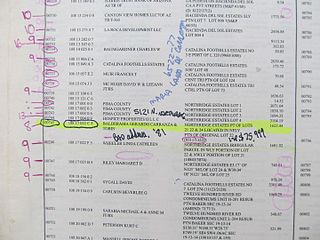A lien is a form of security interest granted over an item of property to secure the payment of a debt or performance of some other obligation. The owner of the property, who grants the lien, is referred to as the lienee and the person who has the benefit of the lien is referred to as the lienor or lien holder.
Service of process is the procedure by which a party to a lawsuit gives an appropriate notice of initial legal action to another party, court, or administrative body in an effort to exercise jurisdiction over that person so as to enable that person to respond to the proceeding before the court, body, or other tribunal.
Adverse possession, sometimes colloquially described as ‘squatter's rights’, is a legal principle under which a person who does not have legal title to a piece of property—usually land —acquires legal ownership based on continuous possession or occupation of the land without the permission of its legal owner.

A lease is a contractual arrangement calling for the lessee (user) to pay the lessor (owner) for use of an asset. Property, buildings and vehicles are common assets that are leased. Industrial or business equipment is also leased.

A tax lien is a lien imposed by law upon a property to secure the payment of taxes. A tax lien may be imposed for delinquent taxes owed on real property or personal property, or as a result of failure to pay income taxes or other taxes.
A surety bond or surety is a promise by a surety or guarantor to pay one party a certain amount if a second party fails to meet some obligation, such as fulfilling the terms of a contract. The surety bond protects the obligee against losses resulting from the principal's failure to meet the obligation.
A declaratory judgment, also called a declaration, is the legal determination of a court that resolves legal uncertainty for the litigants. It is a form of legally binding preventive adjudication by which a party involved in an actual or possible legal matter can ask a court to conclusively rule on and affirm the rights, duties, or obligations of one or more parties in a civil dispute. The declaratory judgment is generally considered a statutory remedy and not an equitable remedy in the United States, and is thus not subject to equitable requirements, though there are analogies that can be found in the remedies granted by courts of equity. A declaratory judgment does not by itself order any action by a party, or imply damages or an injunction, although it may be accompanied by one or more other remedies.
A mechanic's lien is a security interest in the title to property for the benefit of those who have supplied labor or materials that improve the property. The lien exists for both real property and personal property. In the realm of real property, it is called by various names, including, generically, construction lien. It is also called a materialman's lien or supplier's lien when referring to those supplying materials, a laborer's lien when referring to those supplying labor, and a design professional's lien when referring to architects or designers who contribute to a work of improvement. In the realm of personal property, it is also called an artisan's lien. The term "lien" comes from a French root, with a meaning similar to link; it is related to "liaison". Mechanic's liens on property in the United States date from the 18th century.

R v Ron Engineering and Construction (Eastern) Ltd, of 1981 is the leading Supreme Court of Canada decision on the law of tendering for contracts. The case concerned the issue of whether the acceptance of a call for tenders for a construction job could constitute a binding contract. The Court held that indeed in many cases the submission of an offer in response to a call for tenders constitutes a contract separate from the eventual contract for the construction. With the release of the decision, the tendering process practiced in Canada was fundamentally changed.
Security of Payment refers to any system designed to ensure that contractors and sub-contractors are paid even in case of dispute. This can involve a system of progress payments, interim arbitration decisions, or a system which legally requires a company to pay an invoice within a set number of days, regardless of whether the company believes they are accurate.
Statutory holdback or contract holdback is the legal requirement found in most common law jurisdictions' contract law that requires an owner engaging a contractor to hold a particular percentage of payment for a stipulated length of time. This is done to ensure that any and all parties working on a contract are paid. Any subcontractors who have worked on the project are entitled to payment based on quantum meruit, and the courts will allow a lien against any property which their work has improved, should they not receive payment. In order to expedite and simplify the overall process, holdbacks can be claimed against by any subcontractors who are denied payment by the contractor who employed them on the project. Under these conditions, the subcontractor may collect payment from the owner, who then reduces his final payment to the contractor. Note that the subcontractor is entitled to payment based on quantum meruit, irrespective of whether or not the subcontractor has privity of contract with the owner.
In the mechanics lien process, a lien waiver is a document from a contractor, subcontractor, materials supplier, equipment lessor or other party to the construction project stating they have received payment and waive any future lien rights to the property for the amount paid. There are typically four types of lien waivers:

A tax sale is the forced sale of property by a governmental entity for unpaid taxes by the property's owner.
Construction law is a branch of law that deals with matters relating to building construction, engineering, and related fields. It is in essence an amalgam of contract law, commercial law, planning law, employment law and tort. Construction law covers a wide range of legal issues including contract, negligence, bonds and bonding, guarantees and sureties, liens and other security interests, tendering, construction claims, and related consultancy contracts. Construction law affects many participants in the construction industry, including financial institutions, surveyors, quantity surveyors, architects, builders, engineers, construction workers, and planners.

The Miller Act requires prime contractors on some government construction contracts to post bonds guaranteeing both the performance of their contractual duties and the payment of their subcontractors and material suppliers.

A "Little Miller Act" is a U.S. state statute, based upon the federal Miller Act, that requires prime contractors on state construction projects to post bonds guarantying the performance of their contractual duties and/or the payment of their subcontractors and material suppliers.
Retainage is a portion of the agreed upon contract price deliberately withheld until the work is substantially complete to assure that contractor or subcontractor will satisfy its obligations and complete a construction project.
In Mechanics lien law a Notice of Intent to Lien is a type of preliminary notice that warns the property owner, prime contractor, and/or other party on a construction that a mechanics lien or bond claim will be filed unless overdue payments are made within a certain period of time.
In Mechanics lien law a Texas Fund Trapping Notice is a preliminary notice that parties on construction projects who are not directly contracted with the owner send in order to preserve the right to file a mechanics lien in the event of nonpayment in Texas. This document is called a Fund Trapping Notice because its purpose is to inform the party making payment of the value of a contract to ensure that they retain sufficient funds to pay the party furnishing labor or materials.




